Preview: The North Korean launch
By David Wright | April 12, 2012
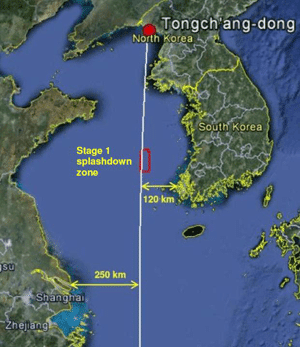
In mid-March, North Korea surprised the world by announcing plans to launch a satellite into orbit sometime between April 11 and April 15 (US time), to commemorate the 100th anniversary of the birth of Kim il-Sung, the revered founder and long-time ruler of North Korea. The imminent launch seemed to fly in the face of the announcement two weeks earlier that the United States and North Korea had agreed to a set of steps that included a ban on long-range missile tests by Pyongyang.
The satellite announcement led to international condemnation of the planned launch for a couple reasons: First, the technology for space-launch vehicles can also be used for long-range missiles armed with nuclear weapons. Even launches aimed at placing non-military satellites in orbit raise concerns that North Korea will gain information that could assist in its program to build military ballistic missiles. After North Korea’s failed launch of a satellite-bearing missile in 2009, in fact, the UN Security Council adopted a resolution demanding that North Korea not conduct “any launch using ballistic missile technology.” Also, North Korea’s previous launch attempts have sent rockets due east from the country, along paths over the main Japanese island early in flight; this routing has led to angry responses from Japan.
North Korea argues that it has the right to a peaceful space program, and that it is taking steps to show it is acting responsibly. It has announced a launch time window and the splashdown zones where the first two stages of the three-stage rocket will fall into the ocean, a common practice that warns ships and aircraft to avoid those areas during the window. It also invited the international press to observe the launch and held briefings and a tour of its facilities before the launch.
And this time North Korea is launching from a new location on the West Coast of the country, and the rocket will fly south, avoiding major land areas. Doing so significantly constrains the launch direction, as Figures 1 and 2 show. The red rectangles in these figures show the announced splashdown zones for the first two stages of the launcher. (The launcher will have three stages, but if it is successful, the third stage will remain in orbit with the satellite.)
Figures 1 and 2.
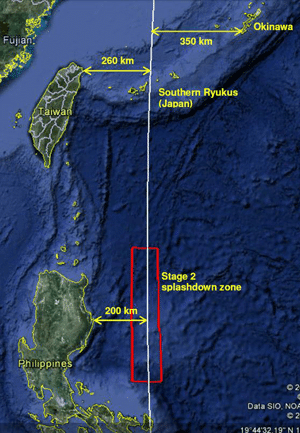
Although this path has drawn complaints from some of the neighboring countries, it is similar to launch paths South Korea used for satellite launch attempts in 2009 and 2010 (see Figure 3). Some may argue that the North Korean launch poses a bigger threat because it likely uses inferior technology, but both of the South’s attempts have failed, in one case dropping debris near Darwin, Australia.
Figure 3.
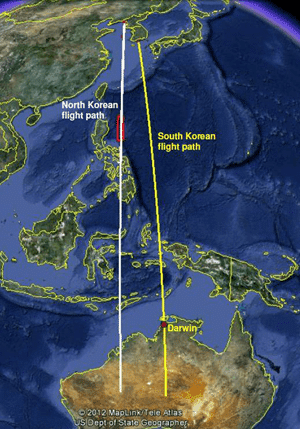
What is known about the launch? Some observers speculated that the new North Korean launcher, called the Unha-3, would be very similar to the Unha-2 rocket used in the 2009 launch attempt, given that the North had been developing this technology for many years. This speculation appeared to be confirmed early in April when reporters visiting the North Korean launch site released photographs of the Unha-3 on the launch pad. Figure 4 shows the Unha-2 from 2009 on the left and the Unha-3 on the right, with red lines marking the stage separations. Allowing for differences in the viewing angles of the pictures, the two rockets appear to have essentially the same length and diameter. From a closeup photograph, it appears that the third stage of the Unha-3 may be longer by 0.3 to 0.4 meters than the third stage on the Unha-2.
Figure 4.
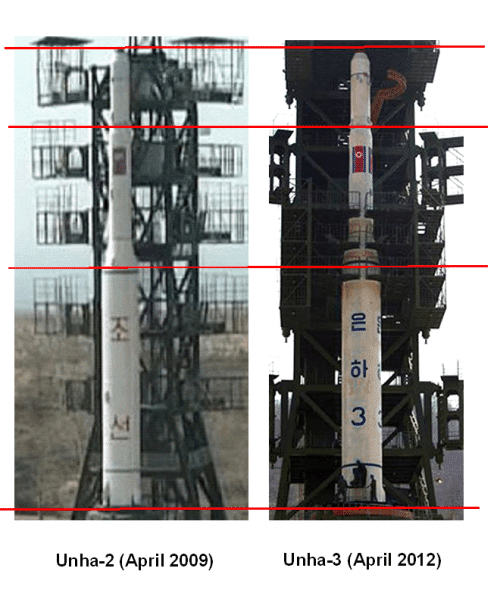
Such a lengthening is not a surprise. When North Korea launched eastward in 2009, its rocket gained speed due to the rotation of earth. This extra speed is 0.35 kilometers per second at the latitude of North Korea, compared to the required burnout speed of about 7.8 km per second to place a satellite in orbit at about 500 km altitude (which Pyongyang announced as the orbital target).
Since North Korea will launch in a southern direction this time, it does not get that boost from the Earth’s rotation and needs more speed from the launcher to place the satellite in a 500-km orbit. An increase in the amount of fuel in the third stage could power that extra acceleration.
Adding that fuel would also add extra mass to the upper stage. Doing so would decrease the speeds at which the first two stages burn out, and these two stages would therefore be expected to splash down somewhat closer to the launch site than in the 2009 launch. And in fact the splashdown zones for the first two stages announced by North Korea do lie closer to the launch site than the 2009 zones.
A computer model of the Unha-2 developed after the 2009 launch, modified to allow for increased fuel in the third stage, places the Unha-3 on a trajectory that agrees with the positions of the announced splashdown zones and that appears able to place a small satellite into orbit at about 500 kilometers. Figure 5 compares the path of the Unha-2 launch in 2009 (red curves) and the predicted path of the Unha-3 (blue path). The broken lines show the paths of the first and second stages of each launcher as they fall to earth after they burn out. The bars along the horizontal axis show the splashdown zones North Korea announced for the two cases.
Figure 5.
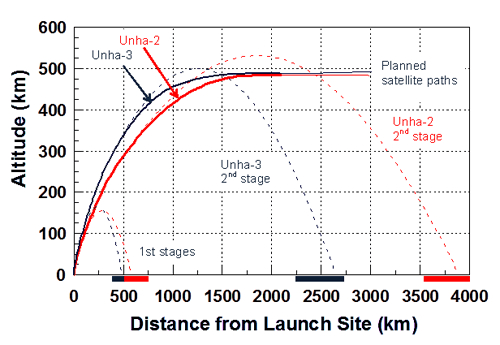
The United States and its regional allies have brought many sensors into the region to gauge the launch. They will be able to quickly verify that it is a satellite launch rather than a test of a long-range missile because the trajectories in those two cases differ in several ways (see Figure 6). A liquid-fueled ballistic missile would burn its engines for about five minutes and the warhead would continue to gain altitude after the rocket engines burn out, since the goal is to travel a long distance. A space-launch vehicle, however, is expected to have the much longer burn time — nine to 10 minutes for the Unha-3 — that is needed to place a satellite at the proper altitude and proper speed, with the trajectory leveling out at the orbital altitude.
Figure 6.
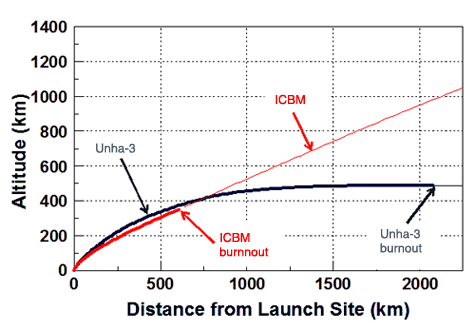
The launch will still teach North Korea about rocket technology it could use in a missile, but it should be clear from the trajectory whether this launch was in fact an attempt to boost a satellite into orbit.
What is the significance of the launch? North Korea has not successfully launched a satellite into orbit. If it succeeds, it would be one of a relatively few countries to have accomplished such a feat. While the satellite is small and not very capable, it would give North Korean engineers practice at communicating with a satellite in orbit. That would be useful in regard to future satellites, even if they were launched for North Korea by another country.
From an economics and reliability standpoint, it would almost certainly make sense for North Korea to buy launch services from other countries rather than develop its own space launcher. The North’s insistence on developing its own booster rockets is one reason that observers tend to see Pyongyang’s space program as a cover for a ballistic missile program. But the same economic and reliability arguments could presumably be made for the South Korean space program, so the argument may not be so simple.
In North Korea’s 2009 launch, the first two stages of the rocket appeared to operate as intended, indicating the North has some knowledge in building and operating a large, multistage rocket. It is unclear how much more it may learn from this launch.
Capability as a ballistic missile and remaining questions. Because the upper stage of this launcher is designed to hold a lightweight satellite, it may not be able to carry a nuclear warhead, which would have a much larger mass, weighing about one ton. But if the third stage could be married to such a warhead, a three-stage ballistic missile based on this technology could theoretically carry it 10,000 km to 11,000 km. Such a range would allow it to reach the West Coast of the United States. If a one-ton warhead were launched on the first two stages of this rocket, it might reach a distance of 8,000 km.
One question that may be answered by the launch is what kind of orbit North Korea is intending for its satellite. Given the launch direction it will be a polar orbit — one that essentially passes over the north and south poles — but North Korea has said that it will be a so-called sun-synchronous orbit. This kind of orbit is typically used by earth-observing satellites. Questions remain as to whether this launch can reach such an orbit, given its constrained launch path, which would require a maneuver by the third stage that would consume considerable fuel.
Perhaps the biggest question about this launch is how much of North Korea’s rocket is indigenously produced. Previous analyses have suggested that it appears to be heavily reliant on Soviet-era technology and possibly on components acquired from Russia. If so, and if North Korea lacks the ability to produce those or more sophisticated components, there may be limits on how far and how fast North Korea’s rockets can advance. But if North Korea has developed an infrastructure that allows it to produce its own components, it may be able to use what it learns from its satellite launches to develop more capable systems in the future.
Together, we make the world safer.
The Bulletin elevates expert voices above the noise. But as an independent nonprofit organization, our operations depend on the support of readers like you. Help us continue to deliver quality journalism that holds leaders accountable. Your support of our work at any level is important. In return, we promise our coverage will be understandable, influential, vigilant, solution-oriented, and fair-minded. Together we can make a difference.
Topics: Nuclear Weapons, Opinion














